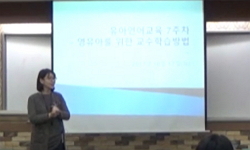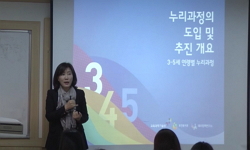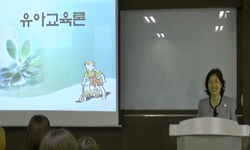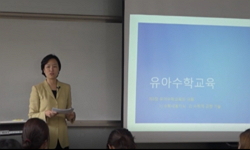본 연구는 유아들의 공격성, 지배력, 또래관계가 맺는 관계를 성별에 따라 분석하는 것을 목적으로 한다. 연구문제는 다음과 같다. 첫째, 신체적, 언어적, 관계적 공격성 및 지배력은 성별에 ...
http://chineseinput.net/에서 pinyin(병음)방식으로 중국어를 변환할 수 있습니다.
변환된 중국어를 복사하여 사용하시면 됩니다.
- 中文 을 입력하시려면 zhongwen을 입력하시고 space를누르시면됩니다.
- 北京 을 입력하시려면 beijing을 입력하시고 space를 누르시면 됩니다.

유아의 공격성, 지배력과 또래관계와의 관련성: 성별을 중심으로 = Relations among aggression, dominance and peer relationships among young children: focusing on sex differences
한글로보기https://www.riss.kr/link?id=A103554488
- 저자
- 발행기관
- 학술지명
- 권호사항
-
발행연도
2017
-
작성언어
-
-
주제어
공격성 ; 지배력 ; 또래관계 ; 성별 ; 유아 ; aggression ; dominance ; peer relationship ; sex differences ; young children
-
KDC
373
-
등재정보
KCI등재
-
자료형태
학술저널
-
수록면
375-393(19쪽)
-
KCI 피인용횟수
1
- DOI식별코드
- 제공처
-
0
상세조회 -
0
다운로드
부가정보
국문 초록 (Abstract)
본 연구는 유아들의 공격성, 지배력, 또래관계가 맺는 관계를 성별에 따라 분석하는 것을 목적으로 한다. 연구문제는 다음과 같다. 첫째, 신체적, 언어적, 관계적 공격성 및 지배력은 성별에 따라 어떻게 다른가? 둘째, 신체적, 언어적, 관계적 공격성, 지배력, 또래관계와의 상관관계는 성별에 따라 어떠한가? 셋째, 신체적, 언어적, 관계적 공격성, 지배력은 성별에 따라 또래관계를 어떻게 예측하는가? 자료수집은 2015 년 12월 - 2016년 1월에 이루어졌으며, P시의 만4-5세 유아 139명과 그들의 담임교사 11명이 참여하였다. 유아들의 공격성과 지배력은 교사용 설문지를 통해 측정하였고 또래관계(또래수용, 또래거부)는 유아와의 1:1 면담을 통해 측정하였다. 자료수집 이후, 분석은 SPSS 23 프로그램을 이용하여 이루어졌다. 또래관계는 각 유아가 받은 호명횟수를 각 학급별로 코딩한 후 표준화 하였으며, 공격성, 지배력은 원점수를 기록하였다. 각 연구문제에 대한 검증을 위하여, t검정, pearson 상관관계, 단계적 회귀 분석을 실시하였다. 결과는 다음과 같다. 첫째, 유아들의 신체적 공격성은 남아에서, 관계적 공격성은 여아에서 더 높게 나타났다. 둘째, 모든 성별에서 신체적 공격성, 관계적 공격성, 언어적 공격성은 서로 밀접하게 관련되어 있었고, 지배력과 또래수용, 또래선호와 정적 상관이 나타났다. 공격성과 또래관계는 남아에서만 상관관계가 나타났다. 셋째, 또래수용과 또래선호를 예측하는 변인은 남아의 경우 신체적 공격성, 관계적 공격성, 지배력이었으며, 여아는 지배력이었다. 이러한 결과는 또래를 수용/거부하는데 있어 성별에 따라 서로 다른 행동이 요구됨을 반영한다. 지배력과 공격성을 고려한 교사의 또래관계 지도방안을 제언하였다.
다국어 초록 (Multilingual Abstract)
This study aims to examine associations among young children’s aggressive behaviors, dominance, and peer relationships by sex. It has three aims, 1) how do physical, verbal, relational aggression and dominance differ by gender? 2) how are physical, ...
This study aims to examine associations among young children’s aggressive behaviors, dominance, and peer relationships by sex. It has three aims, 1) how do physical, verbal, relational aggression and dominance differ by gender? 2) how are physical, verbal, relational aggression and dominance correlated to peer relationships by gender? 3) how do physical, verbal, relational aggression and dominance predict peer relationships by gender? Data were collected from December 2015 to January 2016. One hundred and thirty - nine of 4-5 year old children and their teachers participated. Aggressive behaviors and dominance were measured by their teachers using Teacher Checklist. Peer relationships were measured through individual interview using sociometric measure. The data was analysed by SPSS 23 program. Peer relationships were calculated by the number of nomination which an individual child was nominated by their classmates in peer acceptance and - rejection, and standardized by each class. The raw numbers were used to analyse for aggressive behavior and dominance. To examine each research question, t-test, pearson correlation, and stepwise regressions were conducted. The results showed that 1) boys displayed more physical aggression than girls while girls displayed more relational aggression than boys, 2) physical, relational, and verbal aggression were correlated each other in both sexes. Dominance was positively correlated with peer acceptance and -preference in both sexes. Aggression was correlated with peer acceptance, - rejection, and - preference only in boys, 3) Peer acceptance and -preference were predicted by physical, relational aggression and dominance in boys, and by dominance in girls. The findings showed that different social behaviors required to obtain peer status between boys and girls. Teachers should be aware of the sex differences of behavioral correlates in children’s peer relationships when guiding them.
참고문헌 (Reference)
1 신유림, "자기회귀 교차지연 모형을 적용한 유아기 관계적 공격성과 또래거부의 발달 경향에 대한 종단 연구" 한국유아교육학회 32 (32): 101-115, 2012
2 박성주, "유아들의 사회적 힘의 부정적 사용 양상 및 특성" 한국아동학회 23 (23): 105-121, 2002
3 신유림, "유아기의 신체적 및 관계적 공격성:성차 및 언어, 사회적 능력과의 관련성" 한국유아교육학회 28 (28): 95-111, 2008
4 최인숙, "사회정보처리 구성요소와 정서요인이 유아의 외현적 공격성과 관계적 공격성에 미치는 영향" 한국아동학회 31 (31): 15-34, 2010
5 Pellegrini, A. D., "The roles of aggressive and affiliative behaviors in resource control : A behavioral ecological perspective" 28 (28): 461-487, 2008
6 Henington, C., "The role of relational aggression in identifying aggressive boys and girls" 36 (36): 457-477, 1998
7 Hawley, P. H., "The ontogenesis of social dominance : A strategy-based evolutionary perspective" 19 (19): 97-132, 1999
8 Green, V. A., "The effect of gender context on children's social behavior in a limited resource situation : An observational study" 12 (12): 586-604, 2003
9 Hawley, P. H., "Strategies of control, aggression, and morality in preschoolers : An evolutionary perspective" 85 (85): 213-235, 2003
10 Dodge, K. A., "Social-information-processing factors in reactive and proactive aggression in children's peer groups" 53 (53): 1146-1158, 1987
1 신유림, "자기회귀 교차지연 모형을 적용한 유아기 관계적 공격성과 또래거부의 발달 경향에 대한 종단 연구" 한국유아교육학회 32 (32): 101-115, 2012
2 박성주, "유아들의 사회적 힘의 부정적 사용 양상 및 특성" 한국아동학회 23 (23): 105-121, 2002
3 신유림, "유아기의 신체적 및 관계적 공격성:성차 및 언어, 사회적 능력과의 관련성" 한국유아교육학회 28 (28): 95-111, 2008
4 최인숙, "사회정보처리 구성요소와 정서요인이 유아의 외현적 공격성과 관계적 공격성에 미치는 영향" 한국아동학회 31 (31): 15-34, 2010
5 Pellegrini, A. D., "The roles of aggressive and affiliative behaviors in resource control : A behavioral ecological perspective" 28 (28): 461-487, 2008
6 Henington, C., "The role of relational aggression in identifying aggressive boys and girls" 36 (36): 457-477, 1998
7 Hawley, P. H., "The ontogenesis of social dominance : A strategy-based evolutionary perspective" 19 (19): 97-132, 1999
8 Green, V. A., "The effect of gender context on children's social behavior in a limited resource situation : An observational study" 12 (12): 586-604, 2003
9 Hawley, P. H., "Strategies of control, aggression, and morality in preschoolers : An evolutionary perspective" 85 (85): 213-235, 2003
10 Dodge, K. A., "Social-information-processing factors in reactive and proactive aggression in children's peer groups" 53 (53): 1146-1158, 1987
11 Pellegrini, A. D., "Social dominance in preschool classrooms" 121 (121): 54-64, 2007
12 Hawley, P. H., "Social dominance and prosocial and coercive strategies of resource control in preschoolers" 26 (26): 167-176, 2002
13 Sutton, J., "Social cognition and bullying : Social inadequacy or skilled manipulation?" 17 (17): 435-450, 1999
14 Perren, S., "Social behavior and peer relationships of victims, bully-victims, and bullies in kindergarten" 47 : 45-57, 2006
15 Archer, J., "Sex differences in aggression in real-world settings : A meta-analytic review" 8 : 291-322, 2004
16 Smith, P. K., "School bullying: Insights and perspectives" Routledge 1994
17 Liddell, C., "Resource utilization in groups of black South African adolescents : Gender, age and individual differences" 20 : 231-248, 1997
18 Zimmer-Gembeck, M. J., "Relational and physical aggression, prosocial behavior, and peer relations : Gender moderation and bidirectional associations" 25 (25): 421-452, 2005
19 Crick, N. R., "Relational and overt aggression in preschool" 33 (33): 610-617, 1997
20 Crick, N. R., "Relational aggression, gender, social–psychological adjustment" 66 (66): 710-722, 1995
21 Tomada, G., "Relational aggression, gender, and peer acceptance : Invariance across culture, stability over time, and concordance among informants" 33 (33): 601-609, 1997
22 Hawley, P. H., "Physical attractiveness in preschoolers : Relationships with power, status, aggression and social skills" 45 (45): 499-521, 2007
23 Parker, J. G., "Peer relations and later personal adjustment : Are low-accepted children at risk?" 102 (102): 357-389, 1987
24 Fanger, S. M., "Peer exclusion in preschool children's play : Naturalistic observations in a playground setting" 58 (58): 224-254, 2012
25 Lee, S. H., "Participant roles in peer‐victimization among young children in South Korea : Peer‐, self‐, and teacher‐nominations" 42 (42): 287-298, 2016
26 Nelson, D. A., "Italian Preschoolers' Peer‐status Linkages with Sociability and Subtypes of Aggression and Victimization" 19 (19): 698-720, 2010
27 Hinde, R. A., "Interactions, relationships and social structure" 11 (11): 1-17, 1976
28 Grünigen, R., "Immigrant children's peer acceptance and victimization in kindergarten : The role of local language competence" 28 (28): 679-697, 2010
29 Rodkin, P. C., "Heterogeneity of popular boys : antisocial and prosocial configurations" 36 (36): 14-, 2000
30 Sebanc A. M, "Gendered social worlds in preschool : Dominance, peer acceptance and assertive social skills in boys’ and girls’ peer groups" 12 (12): 91-106, 2003
31 Ostrov, J. M., "Gender differences in preschool aggression during free play and structured interactions : An observational study" 13 (13): 255-277, 2004
32 Cillessen, A. H., "From censure to reinforcement : Developmental changes in the association between aggression and social status" 75 (75): 147-163, 2004
33 Charlesworth, W. R., "Co-operation and competition : Contributions to an evolutionary and developmental model" 19 (19): 25-39, 1996
34 Hymel, S., "Children’s peer relationships : Longitudinal prediction of internalizing and externalizing problems from middle to late childhood" 61 (61): 2004-2021, 1990
35 Putallaz, M., "Children’s naturalistic entry behavior and sociometric status : A developmental perspective" 25 (25): 297-305, 1989
36 Newcomb, A. F., "Children's peer relations : a meta-analytic review of popular, rejected, neglected, controversial, and average sociometric status" 113 (113): 99-128, 1993
37 Killen, M., "Children and social exclusion: Morality, prejudice, and group identity" John Wiley & Sons 2011
38 Olweus, D., "Bullying at school: What we know and what can we do" Blackwell 1993
39 Pellegrini, A. D., "Behavioral and social cognitive processes in preschool children's social dominance" 37 (37): 248-257, 2011
40 Benenson, J. F., "Ages four to six years : Changes in the structures of play networks of girls and boys" 40 (40): 478-487, 1994
41 Crick, N. R., "A review and reformulation of social information-processing mechanisms in children's social adjustment" 115 (115): 74-101, 1994
동일학술지(권/호) 다른 논문
-
Exploring the Narrative of the Transitional Period of an Adolescent Study Abroad Student
- 학습자중심교과교육학회
- A Young Park(박아영)
- 2017
- KCI등재
-
- 학습자중심교과교육학회
- 강민정(Kang, MinJung)
- 2017
- KCI등재
-
IPA를 활용한 체육 안전사고에 관한 초등 교사들의 인식 연구
- 학습자중심교과교육학회
- 강효영(Kang, Hyo-Young)
- 2017
- KCI등재
-
“좋은 학교” 사례 연구: 중산층 지역에 있는 혁신중학교교장의 학교운영과 학부모의 반응
- 학습자중심교과교육학회
- 김미숙(Kim, Misook)
- 2017
- KCI등재
분석정보
인용정보 인용지수 설명보기
학술지 이력
| 연월일 | 이력구분 | 이력상세 | 등재구분 |
|---|---|---|---|
| 2027 | 평가예정 | 재인증평가 신청대상 (재인증) | |
| 2021-01-01 | 평가 | 등재학술지 유지 (재인증) |  |
| 2018-01-01 | 평가 | 등재학술지 유지 (등재유지) |  |
| 2015-01-01 | 평가 | 등재학술지 유지 (등재유지) |  |
| 2011-01-01 | 평가 | 등재학술지 유지 (등재유지) |  |
| 2008-01-01 | 평가 | 등재학술지 선정 (등재후보2차) |  |
| 2007-01-01 | 평가 | 등재후보 1차 PASS (등재후보1차) |  |
| 2006-01-06 | 학술지명변경 | 외국어명 : Journal of Learner-Centered Curriculum and Instruction -> The Journal of Learner-Centered Curriculum and Instruction |  |
| 2006-01-01 | 평가 | 등재후보학술지 유지 (등재후보1차) |  |
| 2004-01-01 | 평가 | 등재후보학술지 선정 (신규평가) |  |
학술지 인용정보
| 기준연도 | WOS-KCI 통합IF(2년) | KCIF(2년) | KCIF(3년) |
|---|---|---|---|
| 2016 | 1.29 | 1.29 | 1.31 |
| KCIF(4년) | KCIF(5년) | 중심성지수(3년) | 즉시성지수 |
| 1.37 | 1.42 | 1.436 | 0.33 |





 스콜라
스콜라






